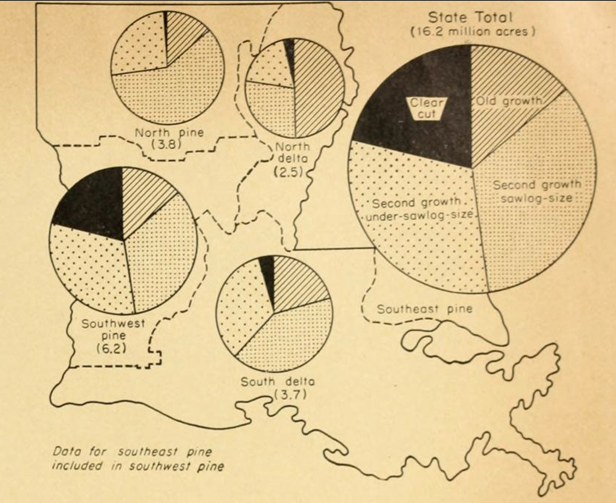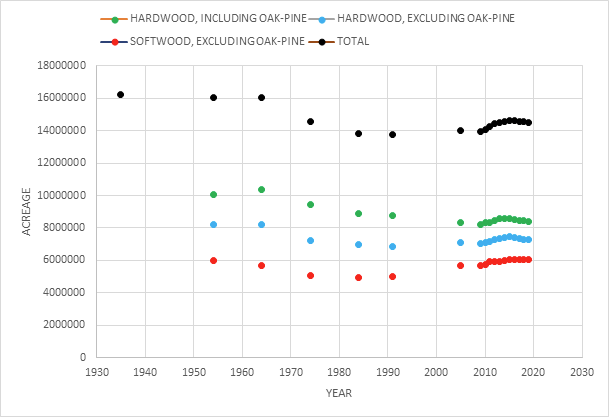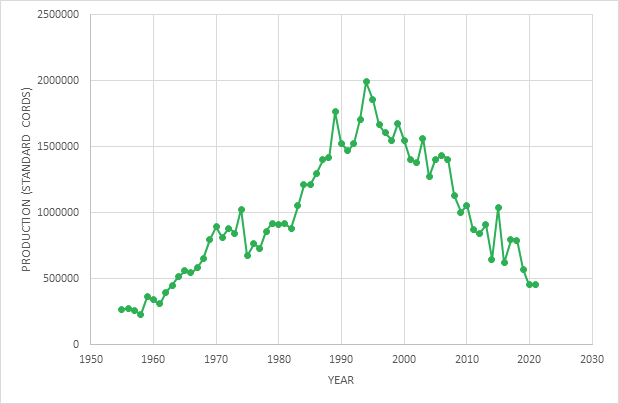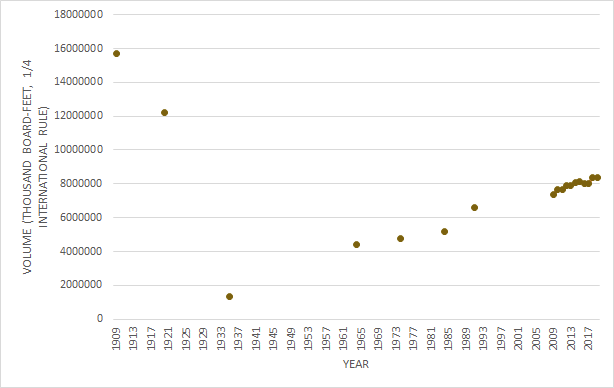The Maturation of Louisiana’s Hardwood Forests
Note: This post has not been peer-reviewed and may be modified in the future.
3/1/2024 – Adjusted horizontal axes of Figures 6 and 12 to more accurately reflect time intervals.
3/26/2024 – Expanded on estimated hardwood volume totals in 1909, broken down by regions within the state. Some of these figures are compared with those from 2020.
3/28/2024 – Added sawtimber estimates from Forbes’ 1921 treatise.
In 1932, it was estimated that the original forest area of Louisiana had been 22.1 million acres, about 76% of the total land area (Campbell and McCraken, 1932). Lockett (1872) and Hilgard (1884) provided detailed descriptions of the forests of the state prior to the advent of large-scale industrial logging. Large areas of upland in West Central Louisiana and the Florida Parishes had contained open forests of longleaf pine (Fig. 1). The uplands in Northwest Louisiana were largely blanketed with mixed pine hardwood forests. The drier ridgetops in this region were often pine-dominated, while the lower slopes and especially the steeper ravines tended to be dominated by hardwoods. On the loessal uplands flanking the Mississippi floodplain, pines were often completely lacking, but became increasingly prominent with increasing distance from the floodplain, as loessal soils gave way to coarser silt loams and sands. Low river terraces throughout the state tended to be hardwood-dominated, with scattered loblolly pines in many areas. The forests of the large river floodplains were completely lacking in pines, instead featuring extensive bottomland hardwood forests, with cypress becoming more prominent toward the coast. The South Louisiana Delta region contained enormous tracts of cypress/tupelo swamp, the largest concentration of such forest on earth.

Fig. 1. Lockett’s 1883 “topographical” map of Louisiana, showing major vegetation regions. Blue – “coast marsh”; orange – “prairies”; pink – “bluff lands,” loessal upland hardwood forest; gray – “pine flats,” open longleaf flatwoods; brown – “pine hills,” open longleaf hills; yellow – “good uplands”, mixed pine-hardwood forest; light green – “alluvial lands,” bottomland hardwood forest; dark green – “wooded swamps.”
Because there is so much gradation between pine-dominated and hardwood-dominated forests, particularly in Northwest Louisiana, it can be somewhat difficult to distinguish between “pine” forest types and “hardwood” types in Louisiana. The Southern Research Station (preceded by the Southern Forest Experiment Station) has long divided Louisiana’s forests into 6 major types. Two of these are considered “softwood” types, the other 4 “hardwood” types. At present, the oak-pine forest type is considered a hardwood type. This is distinguished from loblolly-shortleaf pine, a softwood type, in that the former contains a plurality of hardwoods by basal area or number of trees. Illustrating how nebulous the distinction can be between softwood and hardwood forest types, historically the oak-pine forest type was considered a softwood type.
These major types are in turn divided into numerous sub-types. The most common major hardwood type is oak-gum-cypress. This includes, among others, sweetgum/Nuttall oak/willow oak and baldcypress/water tupelo. Thus cypress, rather than hardwoods, may be the most prevalent species, despite the fact that such forest is considered a “hardwood” type. In past major forest surveys of Louisiana, conducted by the Southern Forest Experiment Station, the acreage of oak-gum-cypress forest has been reported as a single quantity, with no distinction between sub-types. Thus acreages for “hardwood” forest in the state often include cypress-dominated forests.
By the mid 19th century, substantial areas of forest, particularly along the meander belts of the Mississippi River and its larger tributaries and distributaries, had been cleared for agriculture. After the Civil War, sizable tracts of floodplain that had been cleared began to revert to forest. In the early 20th century, industrial logging went into full swing. Cypresses and pines were particularly hard-hit.
In 1909, it was estimated that the forests of Louisiana contained about 36.4 billion board-feet of hardwood sawtimber (Government Printing Office, 1913). Such early estimates were sometimes considered unreliable by later researchers, who often judged them to be underestimates. However, the 1909 estimate was made with extreme care, and it is interesting that data on hardwood sawtimber production in Louisiana (Reynolds and Pierson, 1939) show that about 11.4 billion board-feet were produced from 1909 to 1935, when the first major survey of Louisiana’s forests was conducted by the Southern Forest Experiment Station. At that time, the sawtimber volume of Louisiana’s hardwoods was estimated at about 25.6 billion board-feet, ¼-International rule (Fig. 2). The difference between the 1909 and 1935 estimates is about 10.8 billion board-feet, in good agreement with the production estimate of 11.4 billion board-feet during this period. For Louisiana pine, the difference between the 1909 and 1935 estimates is about 52.2 billion board-feet, in very good agreement with the production estimate of 52.3 billion board-feet during this period. It therefore seems reasonable to accept the 1909 hardwood sawtimber volume estimate as fairly reliable.

Fig. 2. Louisiana sawtimber volume, 1909-2019.
Of the 36.4 billion board-feet of hardwood in Louisiana in 1909, an estimated 13.8 billion resided in the North Mississippi River parishes. Another 9.5 billion resided in the South Mississippi River parishes, and another 10.9 billion in the Red, Sabine, and Pearl River parishes. The remaining 2.2 billion was found in “other” parishes.1 Note that the combined total of the Red, Sabine, and Pearl River parishes and the “other” parishes, which together encompassed almost all of the hardwood forest outside the Mississippi/Atchafalaya floodplain, was only about 5% less than that of the North Mississippi River parishes.
In 1920, Forbes (1921) provided estimates of standing sawtimber in Louisiana. His estimate for hardwood was about 34.4 billion board-feet, only about 6% less than the 1909 estimate. He estimated that in the alluvial bottoms of the state, 1.815 million acres of virgin forest remained, about 25% of the total forest in that region.
In 1934-35, the total forest area of Louisiana was estimated to be about 16.2 million acres (Fig. 3). Unfortunately, at this time the Southern Forest Experiment Station did not distinguish between shortleaf and/or loblolly-dominated uplands and mixed upland forests dominated by hardwoods (Winters et al., 1943). The state contained an estimated 7.6 million acres of bottomland hardwood forest and another 935,000 acres of upland hardwood forest. About 1.1 million acres (24%) of the bottomland hardwood forest was outside the North and South Delta regions. Statewide, almost half of the forest was in an either old-growth or second-growth sawlog size condition. In Northwest Louisiana, it was estimated that 46% of the sawtimber volume consisted of hardwoods. In the Southwest and Southeast regions of the state, encompassing almost all of the longleaf pine regions, 43% of the sawtimber volume consisted of hardwoods. The estimated total volume of hardwoods and cypress in the state was about 12.1 billion ft3. The cypress forests of Louisiana had been devastated by this time, and only about 3.2% of the state’s sawtimber volume consisted of cypress, while about 60% consisted of hardwood. Using these values, I estimate that the state contained about 11.7 billion ft3 of hardwood in 1934-35 (Fig. 4). Hardwood sawtimber volume was estimated at about 25.6 billion board-feet, ¼-International rule (Fig. 2). Pine sawtimber volume was estimated at about 15.5 billion board-feet. Thus the volume of hardwood sawtimber in the state, which had been only about half that of pine in 1909, was 65% higher than that of pine in 1935.

Fig. 3. Figure 4 from Winters et al. (1943), showing the survey units created by the Southern Forest Experiment Station and the forest conditions in 1935.

Fig. 4. Total live-tree volume of hardwood in Louisiana, 1935-2019.
From the mid 1930’s to 1954, when the next major forest survey of Louisiana was conducted, despite a great deal of industrial logging in the state, the total area of Louisiana forest declined by less than 1%, to about 16.0 million acres (Fig. 5). In the North Louisiana Delta region, the decline was about 11%. In the South Louisiana Delta region, about 6%. However, the forest area in the Northwest region increased 28% during this time. This was largely due to the abandonment of numerous small upland farms, which then reverted to forest, often hardwood-dominated. Total hardwood acreage in the state at this time was about 8.2 million acres. Surprisingly, total hardwood volume from 1935 to 1954 declined only 8%, to about 10.6 billion ft3 (U.S. Forest Service, 1955). In the South Delta region, hardwood sawtimber volume actually increased 21% during this period, and there were increases in the numbers of live trees in all diameter classes. Statewide, hardwood sawtimber volume was about 25.1 billion board-feet, virtually unchanged from 1935. The authors noted that the growth rate in these forests was about a third higher than that seen in the mid 1930’s, as logging had released many individual trees from close competition.

Fig. 5. Acreage of Louisiana timberland, 1935-2019. Note that “hardwood” here includes the oak-gum-cypress forest type, which in turn includes the baldcypress/water tupelo subtype.
In 1964, when the next major Louisiana forest survey was conducted, the total forest acreage was estimated at 16.0 million acres, virtually unchanged from 1954. The total hardwood acreage was estimated at about 8.2 million acres, also virtually unchanged from 1954. Even in the North Louisiana Delta region, which saw more deforestation during this period than any other in the state, forest acreage in 1964 was 87% of that in 1954. Forest acreage in the Northwest region continued to increase dramatically during this period. Total hardwood volume in the state in 1964 was estimated to be almost 9 billion ft3, about 78% of its mid-1930’s value. Hardwood sawtimber volume was estimated at about 20.3 billion board-feet, 79% of its mid-1930’s value (Sternitzke, 1965).
It was during the late 20th century that hardwood acreage declined significantly in Louisiana, due primarily to the conversion of hardwood forest to agricultural fields. This was most dramatic in the North Louisiana Delta region, which lost 52% of its 1964 forest acreage by 1984 (Fig. 6). Statewide, oak-gum-cypress forest acreage declined 12% during this time, while oak-hickory forest increased 26%. The latter was primarily due to selective cutting of pines in mixed forests. In 1984, the state still contained an estimated 6.94 million acres of hardwood forest, about 85% of its 1964 hardwood acreage. Importantly, despite the loss of acreage, the surviving hardwoods were rapidly maturing during this time. From 1964 to 1984, the total volume of Louisiana hardwoods increased 25% to about 11.2 billion ft3. Hardwood sawtimber volume returned to its mid-1930’s level, increasing 24% to about 25.3 billion board-feet (Rosson et al., 1988).

Fig. 6. Louisiana forest acreage, North Delta region (see Fig. 2).
After 1984, deforestation in Louisiana leveled off, and in the early 21st century, hardwood acreage began to slowly increase. In 2005, oak-pine began to be classified as a hardwood type (Oswalt and Bentley, 2005). As of 2019 the hardwood area of the state was estimated to be about 8.43 million acres2. Meanwhile, forest maturation continued. By 2005, total hardwood volume in the state was about 12.0 billion ft3. In 2019 it was estimated at about 13.9 billion ft3, far exceeding the value of 11.7 billion ft3 in the mid-1930’s, when an estimated 1 million acres of the state’s bottomland hardwood forest remained uncut. Hardwood sawtimber volume in 2019 was estimated at 38.1 billion board-feet, also far exceeding the value of 25.6 billion board-feet in the mid-1930’s, and even exceeding the estimate of 36.4 billion board-feet in 1909. Much of this was outside the Mississippi/Atchafalaya floodplain. As of 2020, the parishes encompassing the Red, Sabine, and Pearl River parishes region, in combination with the “other” parishes, as defined for the 1909 forest survey (Government Printing Office, 1913), which together contain the overwhelming majority of the hardwood forest outside the Mississippi/Atchafalaya floodplain, contained an estimated 17.7 billion board-feet of hardwood sawtimber, 62% more than in 1909, and 28% more than that estimated for the North Mississippi River parishes in 1909.
In 2019, Louisiana’s 8.4 million acres of hardwood forest timberland were divided into 6 major types, as follows:
oak-pine 1,141,700 acres
oak-hickory 1,623,500 acres
oak-gum-cypress 3,846,700 acres
elm-ash-cottonwood 1,409,100 acres
other hardwood 20,000 acres
exotic hardwood 384,800 acres
As can be seen, 46% of the hardwood acreage, about 3.8 million acres, consisted of the oak-gum-cypress type. This type had the highest average wood volume per acre of any major forest type in the state. About half of this forest acreage was classified as fully stocked or overstocked. In these categories, total stem volume averaged 3633 ft3/acre and 5274 ft3/acre, respectively. For comparison, the estimated mean volume in stands 81-100 years of age in this forest type was 3905 ft3/acre. Fully stocked oak-gum-cypress stands averaged 1.7 trees/acre 29+ inches DBH. Overstocked stands averaged 2.8 trees/acre of this size.
There is every reason to expect that Louisiana’s hardwood forests will continue to mature and that mature acreages will increase. Louisiana hardwood sawtimber production peaked in the 1920’s, with a smaller peak in the 1940’s and 1950’s. Since that time it has declined and in 2021 was a small fraction of its early 20th century level (Fig. 7). Hardwood pulpwood production increased in the late 20th century, peaking in 1994. Since then it has declined and by 2021 had returned to levels seen in the mid 1960’s (Fig. 8). Since 1990, a number of federal wildlife refuges and state wildlife management areas have been created in the hardwood-dominated regions of the state. Existing refuges have been and continue to be expanded. In 2013, only 11% of the state’s hardwood acreage was classified as forest industry land. The population of rural Louisiana is slowly hollowing out, leaving many farms and pastures to revert to forest. 25 of the 29 parishes in North Louisiana saw population declines from 2010 to 2020, with 5 parishes (including Madison and Tensas) declining more than 15%. Almost all of the rural parishes in South Louisiana also saw declines. Many large private landowners now lease their forest lands to hunting clubs or enter into conservation arrangements with state and/or federal agencies.

Fig. 7. Annual hardwood sawtimber production in Louisiana. Data prior to 1944 are from Steer (1948). Data after 1943 are from the Louisiana Department of Agriculture and Forestry (https://www.ldaf.la.gov/land/forestry/forestry-reports).

Fig. 8. Annual Louisiana hardwood pulpwood production. These data come from the Louisiana Department of Agriculture and Forestry web site (https://www.ldaf.la.gov/land/forestry/forestry-reports). 1 standard cord = 128 ft3.
In a mere 10-year period, from 2009 to 2019, the total volume of Louisiana hardwoods increased 14.7% (Fig. 9). The number of live hardwoods 29+ inches DBH increased 10.2% to 5.4 million during this period. Were these trends to continue, which seems likely given the decline in hardwood sawtimber and pulpwood production, by 2050 the total volume of Louisiana hardwoods would be about 19 billion ft3, 65% greater than that in 1935. The number of live hardwoods 29+ inches DBH would be about 8.2 million.

Fig. 9. Total hardwood volume in Louisiana, 2009-2019.
It should also be noted that cypress volume in Louisiana has been increasing steadily since the 1930’s, although it is still far below the 1909 estimate (Fig. 10). Another century may be required to return the state’s cypress volume to its pre-logging levels. Pine volume has also increased dramatically since the 1930’s.

Fig. 10. Louisiana cypress sawtimber volume, 1909-2019. The 1909 value comes from Government Printing Office (1913). The 1920 value is from Forbes (1921). Subsequent values are from Winters et al. (1943), U.S. Forest Service (1955), Sternitzke (1965), Rosson et at. (1988), Rosson (1995), and the Forest Inventory Analysis of the U.S. Forest Service.
It should also be noted that the composition of Louisiana’s hardwood forests has changed significantly since presettlement times. In the Mississippi/Atchafalaya floodplain there have been major hydrological alterations. Some areas have seen flooding increase in both depth and frequency, which has enhanced sedimentation rates, increased the mortality of small trees, and reduced undergrowth. Conversely, flood protection over vast areas has reduced nutrient inputs and increased both the prevalence of undergrowth and the density of small trees. Extensive canebrakes were recorded by 19th century surveyors in many of the higher areas of the floodplain (Fig. 11). These have been greatly reduced in area. Since 1964, the acreage of oak-gum-cypress forest in the state has declined significantly, although it has been recovering since 2005. Since 1991, the acreage of elm-ash-cottonwood forest has more than doubled (Fig. 12).

Fig. 11. Canebrakes in 6 townships in the northwestern Atchafalaya Basin, as indicated by surveys conducted by William Darby in 1808 and 1809. The area of the townships examined is outlined in purple. Virtually this entire area was forested at the time. Canebrakes are shown in red. The yellow area was prairie at the time. The townships are: T 2 S R 5 E, T 2 S R 6 E, T 3 S R 5 E, T 3 S R 6 E, T 4 S R 5 E, T 4 S R 6 E.

Fig. 12. Estimated acreages of 3 Louisiana hardwood forest types, 1964-2019.
For the oak-gum-cypress type, Barnett et al. (2023) estimated the onset of maturity at 44-66 years, depending on productivity conditions, and the onset of old-growth conditions (the point at which forest carbon reaches 95% of its asymptotic level) at 90-135 years. For the elm-ash-cottonwood type, the authors estimated the onset of maturity at 46-72 years, and the onset of old-growth conditions at 95-144 years. We may therefore expect that by the middle of this century, many Louisiana hardwood forests will be in an old-growth condition by this definition. Even areas that were clear-cut in the mid 20th century are already well into their mature state at the present time.
1The parishes corresponding to these categories are as follows: North Mississippi River parishes – Caldwell, Catahoula, Concordia, East Carroll, Franklin, LaSalle, Madison, Morehouse, Ouachita, Richland, Tensas, Union, West Carroll; South Mississippi River parishes – Ascension, Assumption, Avoyelles, East Baton Rouge, Iberia, Iberville, Jefferson, Lafourche, Livingston, Orleans, Plaquemines, Pointe Coupee, St. Bernard, St. Charles, St. James, St. John the Baptist, St. Landry, St. Martin, St. Mary, Tangipahoa, Terrebonne, West Baton Rouge, West Feliciana; Red, Sabine, and Pearl River parishes – Bossier, Caddo, Calcasieu, Cameron, DeSoto, Grant, Natchitoches, Rapides, Red River, Sabine, St. Tammany, Vernon, Washington, Winn; “other” parishes – Acadia, Bienville, Claiborne, East Feliciana, Jackson, Lafayette, Lincoln, St. Helena, Vermilion, Webster.
2Data from 2009 to 2019 come from the Forest Inventory Analysis of the U.S. Forest Service (https://www.fs.usda.gov/srsfia/states/louisiana.shtml).
Literature Cited
Barnett, K, G.H. Aplet, and R.T. Belote. 2023. Classifying, inventorying, and mapping mature and old-growth forests in the United States. Front. For. Global Change 5:1070372. (https://www.frontiersin.org/articles/10.3389/ffgc.2022.1070372/full)
Campbell, A.S., and E.M. McCracken. 1932. Studies in Forestry Resources in Florida. I. Timber Conservation. Univ. of Florida Economic Series Vol. 1 No. 3.
Forbes, R.D. 1921. The Why and the How of Forestry in Louisiana. La. Dept. of Conservation Bulletin 7.
Government Printing Office. 1913. The Lumber Industry. Part 1: Standing Timber. Dept. of Commerce and Labor, Bureau of Corporations.
Hilgard, E.W. 1884. Report on the Cotton Production of the State of Louisiana with a Discussion of the General Agricultural Features of the State. Extra Census Bulletin, Government Printing Office.
Lockett, S.H. 1872. Louisiana as It Is: A Geographical and Topographical Description of the State. Pelican Publishing.
Oswalt, S.N., and J.W. Bentley. 2005. Louisiana Forests, 2005. Resource Bulletin SRS-192, Southern Research Station.
Reynolds, R.V., and A.H. Pierson. 1939. Forest Products Statistics of the Southern States. U.S.D.A. Statistical Bull. No. 69.
Rosson, J.F. 1995. Forest Resources of Louisiana, 1991. Resource Bulletin SO-192, Southern Forest Experiment Station.
Rosson, J.F., W.H. McWilliams, and P.D. Frey. 1988. Forest Resources of Louisiana. Resource Bulletin SO-130, Southern Forest Experiment Station.
Steer, H.B. 1948. Lumber Production in the United States, 1799-1946. U.S. Department of Agriculture Misc. Publ. No. 669.
Sternitzke, H.S. 1965. Louisiana Forests. Resource Bulletin SO-7, Southern Forest Experiment Station.
U.S. Forest Service. 1955. Forests of Louisiana, 1953-54. Forest Survey Release 75, Southern Forest Experiment Station.
U.S. Forest Service. 2024. Forest Inventory EVALIDator web-application Version 2.1.1. U.S. Forest Service, Northern Research Station. https://apps.fs.usda.gov/fiadb-api/evalidator
Winters, R.K., G.B. Ward, and I.F. Eldredge. 1943. Louisiana Forest Resources and Industries. U.S. Department of Agriculture Misc. Publ. No. 519.

Pingback: A Shoutout and Some Reasons to Be Cheerful - Project Principalis (Formerly Project Coyote) Ivory-billed Woodpecker Searches in Louisiana